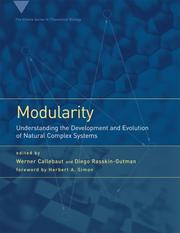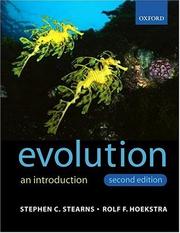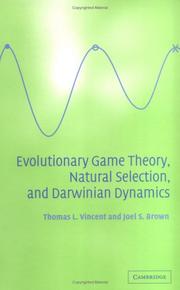| Listing 1 - 10 of 32 | << page >> |
Sort by
|

ISBN: 0262033267 Year: 2005 Publisher: Cambridge (Mass.) : MIT press,
Abstract | Keywords | Export | Availability | Bookmark
 Loading...
Loading...Choose an application
- Reference Manager
- EndNote
- RefWorks (Direct export to RefWorks)
Biocomplexity. --- Chaotic behavior in systems. --- Evolution (Biology). --- Modularity (Psychology). --- Natural selection.

ISBN: 1280956348 9786610956340 0387276513 1417578963 0306482355 1441934375 Year: 2005 Publisher: Georgetown, Tex. : New York, N.Y. : Landes Bioscience/Eurekah.com ; Kluwer Academic/Plenum Publishers,
Abstract | Keywords | Export | Availability | Bookmark
 Loading...
Loading...Choose an application
- Reference Manager
- EndNote
- RefWorks (Direct export to RefWorks)
Selective Sweep deals with the theory and practice of detection of recent adaptive evolution at the genomic level from the patterns of DNA polymorphism. Recent advances in genomic sequencing provide the background for analysis of polymorphic sites in large chromosomal regions or even in whole genome, thus providing the tool for effective identification of loci that are under strong pressure of positive selection. For this reason, the studies of selective sweep, which formerly were of interest mostly to evolutionists, have become widely recognized and appreciated by the large biological community involved in identification of the targets of selection during speciation, host/pathogen interactions, and resistance to chemical agents.
Mutation (Biology) --- Population genetics. --- Natural selection. --- Darwinism --- Selection, Natural --- Genetics --- Variation (Biology) --- Biological invasions --- Evolution (Biology) --- Heredity --- Cytology. --- Cell Biology. --- Cell biology --- Cellular biology --- Biology --- Cells --- Cytologists

ISBN: 0226797627 0226797619 1299730736 022611869X 9780226118697 9780226797618 9780226797625 Year: 2005 Publisher: Chicago University of Chicago Press
Abstract | Keywords | Export | Availability | Bookmark
 Loading...
Loading...Choose an application
- Reference Manager
- EndNote
- RefWorks (Direct export to RefWorks)
Coevolution-reciprocal evolutionary change in interacting species driven by natural selection-is one of the most important ecological and genetic processes organizing the earth's biodiversity: most plants and animals require coevolved interactions with other species to survive and reproduce. The Geographic Mosaic of Coevolution analyzes how the biology of species provides the raw material for long-term coevolution, evaluates how local coadaptation forms the basic module of coevolutionary change, and explores how the coevolutionary process reshapes locally coevolving interactions across the earth's constantly changing landscapes. Picking up where his influential The Coevolutionary Process left off, John N. Thompsonsynthesizes the state of a rapidly developing science that integrates approaches from evolutionary ecology, population genetics, phylogeography, systematics, evolutionary biochemistry and physiology, and molecular biology. Using models, data, and hypotheses to develop a complete conceptual framework, Thompson also draws on examples from a wide range of taxa and environments, illustrating the expanding breadth and depth of research in coevolutionary biology.
Evolution. Phylogeny --- Coevolution. --- Biology. --- Genetics. --- Biology --- Health & Biological Sciences --- Evolution --- Evolution (Biology) --- Co-evolution --- Animal evolution --- Animals --- Biological evolution --- Darwinism --- Evolutionary biology --- Evolutionary science --- Origin of species --- Biological fitness --- Homoplasy --- Natural selection --- Phylogeny --- ecology, evolution, evolutionary, biology, biological, ecological, science, scientists, coevolution, change, species, natural selection, biodiversity, interactions, survival, reproduction, adaptation, coadaptation, genetics, phylogeography, systematics, biochemistry, physiology, populations, dynamics, displacement, convergence.
Book
ISBN: 1280846267 0191513733 1429469277 9780191513732 9781280846267 1383029504 Year: 2005 Publisher: New York : Oxford University Press,
Abstract | Keywords | Export | Availability | Bookmark
 Loading...
Loading...Choose an application
- Reference Manager
- EndNote
- RefWorks (Direct export to RefWorks)
"This book considers evolution at different scales. The focus is on the mathematical and computational tools and concepts, which form an essential basis of evolutionary studies, indicate their limitations, and give them orientation"--Provided by publisher.
Evolution (Biology) --- Phylogeny --- Mathematics. --- Animal phylogeny --- Animals --- Phylogenetics --- Phylogeny (Zoology) --- Animal evolution --- Biological evolution --- Darwinism --- Evolutionary biology --- Evolutionary science --- Origin of species --- Evolution --- Biology --- Biological fitness --- Homoplasy --- Natural selection

ISBN: 0262269694 1423729919 9780262269698 9781423729914 0262033267 9780262033268 Year: 2005 Publisher: Cambridge, Mass. MIT Press
Abstract | Keywords | Export | Availability | Bookmark
 Loading...
Loading...Choose an application
- Reference Manager
- EndNote
- RefWorks (Direct export to RefWorks)
Experts from diverse fields, including artificial life, cognitive science, economics, developmental and evolutionary biology, and the arts, discuss modularity.Modularity--the attempt to understand systems as integrations of partially independent and interacting units--is today a dominant theme in the life sciences, cognitive science, and computer science. The concept goes back at least implicitly to the Scientific (or Copernican) Revolution, and can be found behind later theories of phrenology, physiology, and genetics; moreover, art, engineering, and mathematics rely on modular design principles. This collection broadens the scientific discussion of modularity by bringing together experts from a variety of disciplines, including artificial life, cognitive science, economics, evolutionary computation, developmental and evolutionary biology, linguistics, mathematics, morphology, paleontology, physics, theoretical chemistry, philosophy, and the arts.The contributors debate and compare the uses of modularity, discussing the different disciplinary contexts of "modular thinking" in general (including hierarchical organization, near-decomposability, quasi-independence, and recursion) or of more specialized concepts (including character complex, gene family, encapsulation, and mosaic evolution); what modules are, why and how they develop and evolve, and the implication for the research agenda in the disciplines involved; and how to bring about useful cross-disciplinary knowledge transfer on the topic. The book includes a foreword by the late Herbert A. Simon addressing the role of near-decomposability in understanding complex systems.
Evolution (Biology) --- Natural selection. --- Chaotic behavior in systems. --- Modularity (Psychology) --- Biocomplexity. --- Natural selection --- Chaotic behavior in systems --- Biocomplexity --- Biology --- Health & Biological Sciences --- Evolution --- Biological complexity --- Complexity, Biological --- Chaos in systems --- Chaos theory --- Chaotic motion in systems --- Darwinism --- Selection, Natural --- Faculty psychology --- Modules (Psychology) --- Animal evolution --- Animals --- Biological evolution --- Evolutionary biology --- Evolutionary science --- Origin of species --- Biodiversity --- Differentiable dynamical systems --- Dynamics --- Nonlinear theories --- System theory --- Genetics --- Variation (Biology) --- Biological invasions --- Heredity --- Human information processing --- Biological fitness --- Homoplasy --- Phylogeny --- BIOMEDICAL SCIENCES/Evolution --- BIOMEDICAL SCIENCES/General

ISBN: 1280656794 9786610656790 038725160X 0387251596 1441937765 Year: 2005 Publisher: New York : Springer,
Abstract | Keywords | Export | Availability | Bookmark
 Loading...
Loading...Choose an application
- Reference Manager
- EndNote
- RefWorks (Direct export to RefWorks)
The editors and contributors to this volume should be justifiably proud of their participation in the tenth triennial meeting of the Chemical Signals in Vertebrates International Symposium. This meeting was held 27 years after the initial gathering of participants in Saratoga Springs, New York from June 6* to 9*, 1976. Subsequent meetings have been held every three years in Syracuse, New York; Sarasota, Florida; Laramie, Wyoming; Oxford, England; Philadelphia, Pennsylvania; Tubingen, Germany; Ithaca, New York; and Krakow, Poland. This tenth aimiversary symposium was held from July 29* through August 1*' in Corvallis, Oregon and was hosted by the Zoology Department and Biology Programs of Oregon State University. This book also represents the tenth in a series of books on chemical communication, chemical ecology, olfactory and vomeronasal research in vertebrate species. The species covered in the chapters herein range from fish to mammals including humans. By taxonomic breakdown the mammals are the most represented in number of species and chapter contributions. However, the hosts of the meeting endeavored to have some representative contributions covering all of the major vertebrate taxa. As in past years, the meeting was well-represented with just over 100 participants from 13 different nations. Plenary talks focused on some of the non-mammalian groups that have tended to be less represented in these symposia. Thus, we had a very nice overview of comparisons and contrasts of invertebrate chemical commimication to vertebrate systems.
Chemical senses --- Vertebrates --- Physiology --- Ecology. --- Evolution (Biology). --- Vertebrates. --- Zoology. --- Evolutionary Biology. --- Biology --- Natural history --- Animals --- Vertebrata --- Chordata --- Animal evolution --- Biological evolution --- Darwinism --- Evolutionary biology --- Evolutionary science --- Origin of species --- Evolution --- Biological fitness --- Homoplasy --- Natural selection --- Phylogeny --- Balance of nature --- Bionomics --- Ecological processes --- Ecological science --- Ecological sciences --- Environment --- Environmental biology --- Oecology --- Environmental sciences --- Population biology --- Ecology --- Ecology . --- Evolutionary biology.

ISSN: 13582461 ISBN: 0521678455 0511599722 9780521678452 9780511599729 Year: 2005 Volume: 56 Publisher: Cambridge Cambridge University Press
Abstract | Keywords | Export | Availability | Bookmark
 Loading...
Loading...Choose an application
- Reference Manager
- EndNote
- RefWorks (Direct export to RefWorks)
It has been claimed that following the decline of Marxism and Freudianism, Darwinism has become the dominant intellectual paradigm of our day. In the mass media there are many bitter disputes between today's new Darwinians and their opponents, often over religion. But the 'neo-Darwinian paradigm' is not as simple or as seamless as either its advocates or its opponents would sometimes have us believe. Biology is in a state of development which defies the standard stereotypes. The papers in this volume, written by some of the leading philosophers in the field, bring out many of the fascinating and complex issues which arise in current attempts to account for life and its development.
Biology --- General ethics --- Animal evolution --- Animals--Evolution --- Animaux--Evolution --- Biological evolution --- Biologische evolutie --- Darwinism --- Darwinisme --- Dieren--Evolutie --- Evolutie (Biologie) --- Evolution (Biologie) --- Evolution (Biology) --- Evolution biologique --- Origin of species --- Philosophy --- Animals --- Evolutionary biology --- Evolutionary science --- Evolution --- Biological fitness --- Homoplasy --- Natural selection --- Phylogeny --- Vitalism --- Arts and Humanities --- Biology - Philosophy --- Philosophy.

ISBN: 0199255636 9780199255634 Year: 2005 Publisher: Oxford Oxford university press
Abstract | Keywords | Export | Availability | Bookmark
 Loading...
Loading...Choose an application
- Reference Manager
- EndNote
- RefWorks (Direct export to RefWorks)
The second edition of Evolution introduces the basic mechanisms of microevolution, natural selection, and macroevolutionary processes such as speciation and extinction. It also examines key events in evolution throughout the geological record and discusses coevolution and evolutionary medicine. In addition, the text discusses unsolved problems and looks ahead to future developments in this dynamic field. The text is organized into five parts. Part One introduces the basic mechanisms of microevolution: selection, inheritance, and development. Part Two considers how natural selection has designed organisms for reproductive success. Part Three explores macroevolutionary processes such as speciation and extinction. Part Four examines key events in evolution throughout the geological record. Part Five discusses coevolution and evolutionary medicine, which integrate and contrast micro- and macroevolution. The book closes with a chapter that recapsulates major issues, discusses unsolved problems, and looks ahead to future developments in this dynamic field. Evolution, Second Edition, is ideal for introductory undergraduate courses in evolutionary biology. A companion website contains downloadable images from the text, interactive simulations to help students explore the subject in a hands-on manner, and additional study questions with answers. Access it at http://www.oup.com/uk/booksites/content/0199255636/.
Evolution (Biology) --- Evolution (Biologie) --- Evolution. --- 575.8 --- 575 --- Evolution. Origin of species. Phylogeny --- General genetics. General cytogenetics. Immunogenetics. Evolution. Speciation. Phylogeny --- Evolution (Biology). --- 575 General genetics. General cytogenetics. Immunogenetics. Evolution. Speciation. Phylogeny --- 575.8 Evolution. Origin of species. Phylogeny --- Animal evolution --- Animals --- Biological evolution --- Darwinism --- Evolutionary biology --- Evolutionary science --- Origin of species --- Biology --- Evolution --- Biological fitness --- Homoplasy --- Natural selection --- Phylogeny

ISBN: 9780521841702 0521841704 9780511542633 9781107406513 0511113439 9780511113437 0511112920 9780511112928 0511542631 1280415878 9781280415876 1107151422 9786610415878 0511181639 0511198477 0511299389 Year: 2005 Publisher: Cambridge New York Cambridge University Press
Abstract | Keywords | Export | Availability | Bookmark
 Loading...
Loading...Choose an application
- Reference Manager
- EndNote
- RefWorks (Direct export to RefWorks)
All of life is a game, and evolution by natural selection is no exception. The evolutionary game theory developed in this 2005 book provides the tools necessary for understanding many of nature's mysteries, including co-evolution, speciation, extinction and the major biological questions regarding fit of form and function, diversity, procession, and the distribution and abundance of life. Mathematics for the evolutionary game are developed based on Darwin's postulates leading to the concept of a fitness generating function (G-function). G-function is a tool that simplifies notation and plays an important role developing Darwinian dynamics that drive natural selection. Natural selection may result in special outcomes such as the evolutionarily stable strategy (ESS). An ESS maximum principle is formulated and its graphical representation as an adaptive landscape illuminates concepts such as adaptation, Fisher's Fundamental Theorem of Natural Selection, and the nature of life's evolutionary game.
Evolution --- Natural selection --- Game theory --- Théorie des jeux --- Mathematical models --- Modèles mathématiques --- Game theory. --- Mathematical models. --- Théorie des jeux --- Modèles mathématiques --- Games, Theory of --- Theory of games --- Mathematics --- Darwinism --- Selection, Natural --- Genetics --- Variation (Biology) --- Biological invasions --- Evolution (Biology) --- Heredity --- Philosophy --- Creation --- Emergence (Philosophy) --- Teleology

ISBN: 0878931872 9780878931873 Year: 2005 Publisher: Massachusetts Sinauer Associates
Abstract | Keywords | Export | Availability | Bookmark
 Loading...
Loading...Choose an application
- Reference Manager
- EndNote
- RefWorks (Direct export to RefWorks)
Evolution (Biology) --- Evolution (Biologie) --- Evolution (Biology). --- 575.8 --- 575 --- 575.8 Evolution. Origin of species. Phylogeny --- Evolution. Origin of species. Phylogeny --- 575 General genetics. General cytogenetics. Immunogenetics. Evolution. Speciation. Phylogeny --- General genetics. General cytogenetics. Immunogenetics. Evolution. Speciation. Phylogeny --- Animal evolution --- Animals --- Biological evolution --- Darwinism --- Evolutionary biology --- Evolutionary science --- Origin of species --- Biology --- Evolution --- Biological fitness --- Homoplasy --- Natural selection --- Phylogeny --- Evolution. Phylogeny --- Acqui 2006
| Listing 1 - 10 of 32 | << page >> |
Sort by
|

 Search
Search Feedback
Feedback About UniCat
About UniCat  Help
Help News
News